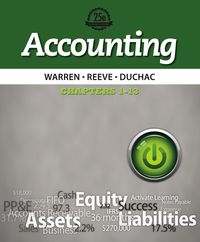I need help with qn 1(b) only. I have the answers to year 1 return on company's stocks, but I need the answer (detailed explanation) to "Is the stock return affected by the choice of accounting policy? comment." Thanks!

These are the answers/commentaries:
Question 1 Consider an equity-financed special purpose company set up for a two year project after which the company is liquidated. Its cost of equity capital is 10%. There are no taxes. At the start of year 1, it has a book value of equity of 350 million and it then spends 40 million on R&D. At the end of year 1, it pays a dividend of 50 million. We also have, before making allowance for any R&D related expense. Year 1 Year 2 Comprehensive income ( million) 60 100 (a) Use the PVED (present value of expected future dividends) model to calculate the value of the company's equity at the start of year 1 and year 2, (1) assuming that R&D costs are expensed in the year in which they are incurred (5 marks) (ii) assuming that R&D costs are capitalised and then amortised equally over the two years. (5 marks) Examiners' commentaries 2018 (b) Calculate the year 1 return on the company's stock if the market value equals the intrinsic value implied by your valuation, assuming that R&D costs are expensed in the year in which they are incurred. Is the stock return affected by the choice of accounting policy? Comment. (5 marks) (e) Provide an analytical discussion of one of the following two questions. Either: (1) Would it be possible to the improve comparability of financial statements within an industry, and hence to improve the informational efficiency of equity markets, by reducing management discretion in financial reporting? Ort (1) When undertaking financial analysis, should we pay more attention to cash flow information or to earnings information? (10 marks) (a) (i) PVED, expensing R&D In millions: DIV DIV2 = CSE2 50 book value of common shareholders' equity (net assets) upon liquidation CSE, 350 CSE = CSE+ CE - DIV 350+ (60 - 40) -50 = 320 CSE2 = CSE + CE, 320 + 100 -0 =420 Dividend discount model (PVED/DDM): Value of equity beginning of year 1: 50 420 Vo = 392.56. 1+ 10%" (1+10%) Value of equity beginning of year 2: 420 Vi = 381.82. 1 + 10% (ii) PVED, capitalising R&D In millions: CSE 350 CSE) = CSEO + CE, - DIV 350+ (40 - 20) + (60 - 20) - 50 = 360 CSE2 = CSE, + CE2 (360 - 20)+(100 - 20) = 420 Dividend discount model (PVED/DDM): Value of equity beginning of year 1: 50 420 + 392.56. 1 + 10% (1 + 10%) Value of equity beginning of year 2: 420 381.82. 1 + 10% The valuation is independent of the accounting scheme adopted (conservative / aggressive). Vo = Vi = 5 (b) Expected stock return implied by our valuation: Vi - Vo+D 381.82-392.56 + 50 Vo 392.56 1 = = 10%. The stock return depends on: the market values of equity (VV) the dividend paid (D) all of which are independent of the accounting scheme adopted conservative / aggressive). (c) (1) Accounting Analyreio annuntiatand










